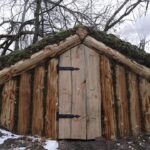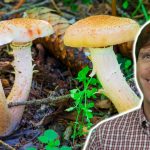How to forage for and make drinks from wild plants, with Bompas & Parr
Hi, I’m Danny, I’m the head chef Bompas & Parr Today we’re gonna be taking a walk about, green spaces and parks, flooding some hedgerow berries and foraged plants to bring home and make some incredible drinks. Ok, so lets head out and do a bit of foraging, and when we get back, we’re going to use some basic equipment that you will have in your kitchen. And some simple ingredients from your pantry, to make some cordials and brew some teas, from whatever we can find. We here at a wetlands in North London, and at this time of the year, late summer, we’ll be looking for berries, edible plants and wildflowers. So we’re going to take a walk around the different parts of the wetlands and see what we can find. Berries can usually be found along hedgerows and on bushes. And edible plants grow in shadowy patches and along paths. Here we have a patch of young nettles that we found in the woodlands, when cutting them always wear gloves because they have a nasty sting. Young nettles are better than old ones but make sure you leave a few leaves on the stalk to encourage new growth. Elderbushes both produce elderflowers in early summer and then elderberries in late summer. So when you’ve picked your elderflowers in early summer, and made yourself some lovely elderflower cordial, those flowers that aren’t picked and get pollinated, turned into elderberries. So you can come back at the end of summer, take some to make some elderberry jam out elderberry cordial. When cutting of elderberries always use scissors snip off the bunches and made sure that you leave some behind, so the wildlife have a food source. Blackberries can be found in hedgerows both near water and land. There are very a hardy plant and grow pretty much anywhere in the UK and most parts of Europe. In late summer, the berries start to ripen and you can tell the ones to pick by their deep purple colour. As well as berries and edible plants, you’ll also find an abundance of wildflowers, lots of which are edible, such as this one, the thistle. Now we’ve got a really good selection of berries, plants, and flowers. Let’s head back to the kitchen and make some drinks. So we’ve just been for a walk around the local wetlands. We found some elderberries, some nettles, some wildflowers, and some blackberries. From these we’re going to make some cordials and we’re going to make some nettle tea and then we’re going to use those to make the final drinks. We’re going to start off by washing our nettles before we make a cordial or make a tea from them. I will put some gloves on to stop myself from getting stung. And then we’re going to take them and submerge them in some clean water, cold water, and then drain them off. So once you have given them a good rinse, drain off the excess and I can see in the bowl that we’ve got fewer bits of debris. Drain them off into a colander over a bowl and repeat. Okay, so we’ve got about three handfuls of nettles here, we will take one of those handfuls, put them into this heat proof jug. And then we’re going to pour over about 500ml of water boiled water. Now, we’re going to leave that to infuse and brew, I can already smell a lovely nettle aroma coming up so we’re going to just set that aside to completely cool. Now, we’re going to make the nettle cordial, we do this by adding 250g of caster sugar to a pan and add 250ml of water, bring that to the boil to dissolve the sugar. And then we are going to add the remaining nettles into the hot sugar syrup and leave it to cool completely. So now we’re going to wash the elderberries. So just take a handful and submerge into the cold water, give them a little agitate, drain them off, place in the colander and just repeat until they are all done. Now we need to get the berries off the stems. So, just take a cluster and just gently tease them off with your fingers and any ones that aren’t quite right if you are gentle enough, will stay on the stems but if they do go it doesn’t really matter that much. And just repeat this until you’ve got all the berries off. So now we’ve got the berries off the stems, we’re just going to look at the bowl and remove any really big bits of stem that found it’s way in there. If there are any kind of little bits of stem in which there will be, don’t worry too much because you’re going to strain out the final product. any they won’t affect the flavour that much. So now we’re going to make the elderberry cordial, this is exactly the same process in the nettle cordial so all you need to do is take 250ml of water, add it to a pan, add 250g of sugar, put that on the heat and bring it to a boil. And now we’re going to add the elderberries, and then let it cool completely. So while the sugar syrup is on the heat We’re going to follow exactly the same process, but with the blackberries. So now the nettle tea is cooled completely, we’re going to strain it off. You could do that by using either a fine sieve or a nut milk or jelly bag. Simply pass it through, and then with the back of the spoon give it a little squidge get all that lovely nettle-ness out. And also just so you know, they now no longer sting you. Now the elder berries and sugar syrup should have cooled completely, we’re going to strain it off. So again, you can do this with a fine sieve or a jelly bag or a nut milk bag, its a really good idea at this point to give a little squeeze. Just to get a really nice, vivid colour. But you don’t want to push it so hard that you start pushing the pulp through the sieve. And if you’re doing this in the nut milk or jelly bag just kind of give it a little twist. So now we’ve strained our elderberry syrup we’ve got our elderberry cordial All you’ve got to do now is follow the same process with the nettles and the blackberries. So now that we have strained off all our cordials we can bottle them, so pour it into a sterilised bottle. As long as your bottle is sterilised, it will keep in the fridge for up to a month. So the first drink we’re going to make is going to be our nettle iced tea. So, we need a highball glass, and I am going to fill that with ice. And then, I am going to take a shaking tin, add some ice, and add some of your nettle tea. A good old splash, and give it a good old shake, and then strain it into the serving glass and then we’re going to add 50ml of the nettle cordial. Give that a little stir And then we’re going to add a lemon twist. Just get those essential oils, squeeze that over the glass and put it in. A mint sprig, give it a slap to release those aromas. And then we’re going to finish it with a little fellow stinging plant, which is a thistle. add a straw and serve. So now we’re going to make the blackberry bramble. First of all, fill your glass with ice, then add your soda water. Fill your glass to about an inch and a half from a top. Then we’re going to add 15ml of apple cider vinegar. 50ml of the blackberry cordial, give it a gentle stir so that we don’t knock up too many bubbles Then it’s a couple of blackberries. on top of the glass, followed by wildflowers, add a straw and serve. So this one is called an elderberry, beetroot cooler, so fill your glass with ice. add 50ml of the elderberry cordial, add 50ml of beetroot juice. Top that with soda, and again, gentle stir so that we don’t knockout the bubbles. And then we’re going to add an orange slice, and a sprig of mint. Give it a slap to release the aroma, add the straw and serve. If you want to turn any of these drinks, cocktails, a measure of gin or vodka would work perfectly with any of these drinks. Thanks for coming along to make these foraged feral beverages with me. And I really hope you enjoy making the products at home, we’ve gone on a really big journey today, we went out into the wild and picked our own produce we brought it into the kitchen and we’ve made our products and a range of cordials and a tea, and then with those, we made our final drinks. So those products that we’ve made are very versatile and you can use it in a million different ways. When you do go foraging just pick and take what you need. It’s a food source to local wildlife in the area. So what we foraged today is local to us here in London. If you’d like to find out what’s local to you, and what would be good at certain times of the year. There are plenty of resources online that will also give you lots of guidance on how to forage safely.



